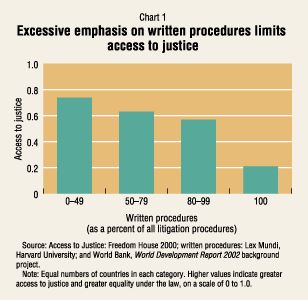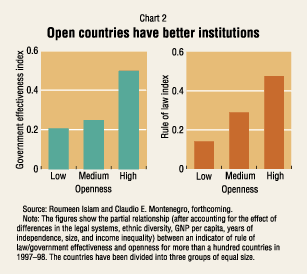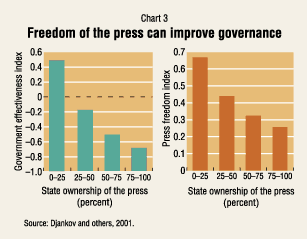 About F&D Subscribe Back Issues Write Us Copyright Information Free Email Notification Receive emails when we post new
items of interest to you. |
Institutions to Support Markets Roumeen Islam To spur growth and reduce poverty, poor countries will need efficient formal and informal institutions that support market activity. A major World Bank study offers insights into how such institutions may be developed. In the eleventh century, the Maghribi merchants of North Africa wanted to expand their business throughout the Mediterranean region. Although cross-border trade was generally free and unrestricted, it was fraught with uncertainty and risk. Selling prices in foreign markets were unknown, and merchants could ensure the safe arrival and sale of their goods only by accompanying shipments to foreign trading centers. The Maghribis established agents in all of the major trading centers around the Mediterranean to represent their interests and gather information on foreign markets. Because the agents were from the Maghribi community, they were trusted. The merchants no longer had to travel to ensure that they were not being cheated, and information flowed freely. The informal institution they developed to deal with problems commonly faced by market participants allowed mutually beneficial business relationships and cross-border trade to flourish. This is one of the many examples cited in the World Bank's World Development Report 2002: Building Institutions for Markets, which addresses the question of what kinds of institutions developing countries need to support their fledgling market economies. The report takes as a given that institutions matter, moving the debate forward by exploring how governments can build better institutions to support market development. It concludes that we need to build on existing institutions, seek simpler solutions in poor countries, and look at both the supply and the demand sides. The challenge now for these countries and the international community is to put these insights to work. Identify institutional problems The first step is recognizing when institutional inadequacies are to blame for problems in developing countries. This means asking which institution is missing or not working properly. Here, we define institutions as rules (informal customs as well as laws) that govern behavior, the mechanisms (often organizations or reputations) that enforce these rules, and the organizations (for example, clubs and banks) that affect peoples' incentives and support market transactions. We have learned that attention needs to be focused, first, on the functions that institutions need to perform, and, second, on a particular institutional design or structure. Institutions that support market transactions perform three functions: smoothing information asymmetries (that is, ensuring that all market participants have access to reliable information), defining and enforcing property rights and contracts, and regulating competition. By focusing on needed functions, governments can figure out whether the problems they face are caused by institutional failures and, if so, what kind. An Eastern European country found that its small and medium-sized firms were unable to obtain financing, even though it had created special banks to provide financing to these types of firms. The special banks proved to be risk averse and did not want to lend to smaller enterprises. What the country really needed was not specialized banks but an institution that decreased lenders' perception of risk or reassured them that they would be able to recover their loans—for example, a court that enforced small claims. Once it is decided what type of institution is needed, the next step is getting the right design and building consensus for reform. For some reforms, the demand is already there; for others, various groups might need to be convinced; and for still others, there is neither opposition nor support. But one thing is certain: institutional change never occurs in a vacuum. It alters the impact of existing laws, so identifying the groups or individuals the new institutions will affect is critical. At least in the short term, there are likely to be losers as well as winners. It is also important for policymakers to be aware of the incentives the new institutions will create—that is, the rewards and penalties for not complying with new rules and regulations—which will be heavily influenced by the kinds of institutions that exist already. Supply the right institutions What lessons have we learned about getting the design right? The first is that, to be effective, institutions need to complement existing conditions in a country. For example, every society has its own way of dealing with disputes. In small, closed communities, where it is easy to obtain information about the parties involved, many conflicts are resolved by the community elders. As trading between communities expands, new, formal institutions may be needed to resolve conflicts, but if these diverge too dramatically from community values, no one will abide by their decisions. A compromise between the old and the new—between a community's informal institutions and the needs of the outsiders with whom it trades—must be reached. In societies with low literacy rates, widespread poverty, a lack of trained lawyers, and an unwillingness to have matters adjudicated by outsiders, simpler and cheaper legal systems that adapt existing methods can be more effective than sophisticated, formal courts. Thus, in designing institutions, policymakers need to take into account such factors as per capita income, the existence of supporting institutions, the availability of necessary technologies, education and skill levels, existing levels of real or perceived corruption, and market size. In a country where poverty is widespread and the cost of access to institutions is high, a large part of the population will not have access to the country's formal institutions. In societies that already have high levels of corruption, certain structures may further facilitate corruption. A recent study covering about 100 countries looked at how swiftly judges adjudicated and who had access to justice. It found that procedural complexity in small-debt collection cases significantly reduced access to the judicial system as well as the latter's efficiency—overly complex regulations create opportunities for bribes and corruption. Requiring all procedures to be written significantly affected access to justice (Chart 1). Moreover, litigation takes longer in countries with procedurally complex court systems, although expected benefits may not materialize.  The second lesson is that, even after adjusting for systematic differences—for example, income, skills, technological sophistication, corruption, existing complementary institutions—some experimentation and innovation, by the countries themselves and by those seeking to help them, may also be necessary to accommodate differences in natural endowments and cultural expectations. For example, countries setting up new bankruptcy laws may need to make adjustments based on social attitudes toward the appropriate treatment of creditors and debtors. Technological and organizational innovation can arise in either the government or the private sector; however, the government plays a critical role because it can stifle or kill innovation through neglect. In Peru, an enterprising individual—Hernando de Soto—demonstrated the role innovation can play in improving institutions. In the 1980s, while conducting a study on the difficulties the poor encounter in trying to set up businesses in the formal sector and acquire legal title to property, he discovered that a poor person in Lima living in an extralegal housing settlement had to overcome tremendous bureaucratic hurdles to acquire legal title to the home, even though the settlement was recognized by the government. Eleven government agencies were involved, and it took 728 bureaucratic steps to get approval from just one of these, the municipality of Lima. He and his colleagues conducted a 10-year information campaign, which generated overwhelming public support for reform. As a result, the Peruvian congress unanimously passed legislation to formalize titles. Today, a simple legal procedure for establishing land titles for poor people works in parallel with the formal system. This story shows how the state can work with private individuals to promote institutional innovation by directly supporting experiments—or at least by allowing them to proceed and be tested. Create demand for institutions Supplying the right institutions is only half the battle. Policymakers also need to create the demand for them and the conditions that foster innovation. Which brings us to the third lesson: opening up trade in goods, services, and information can pave the way for other far-reaching institutional changes by influencing demand for institutions as well as the supply of new ideas and designs. A small, closed rural community in Mongolia has little need for institutions supporting trade with other communities: disputes between community members can be resolved through mediation; everyone knows how creditworthy everyone else is; and community members cooperate, rather than compete, with each other. But there are few economic opportunities. Isolated communities need to find markets in which to sell their goods. Opening up trade will lead to better-quality, formal institutions. As people learn from each other, they will start demanding better institutions—as well as participate in creating them. Evidence shows that a country's openness is closely linked with the quality of its institutions, even after accounting for differences in income, size, type of legal system, ethnic diversity, initial income inequality, and how long the country has been independent, among other things (Chart 2). The effect of institutions on trade and of trade on institutions is, of course, a two-way street: if developed countries erect new and sophisticated trade barriers as developing countries reduce their trade barriers, the restriction of trading or market opportunities will reduce the demand for, and the supply of, institutions that support trade in developing countries.  Similarly, institutions like the media that disseminate information can improve the quality of other institutions by monitoring the performance of key individuals, groups, and organizations. The media play a critical role in fighting corruption; by reporting on public officials, they make them accountable for their actions. The media may also spur the development of markets by improving the flow of economic information. The information available to the media and the independence and freedom they enjoy can have dramatic consequences (Chart 3).  The fourth lesson is that competition between jurisdictions, regions, and countries can enhance institutional quality and flexibility—again by affecting the demand for particular institutions as well as the supply of new ones. The most effective institutional structures may emerge as a result of such competition, particularly in light of the stakes—the areas with the best institutions will be able to attract, for example, the most private investment, talent, or even, in some cases, federal funding. There is no reason for different regions within large and diverse countries like India and Brazil to build institutions in exactly the same way. In either country, the tension between innovation, competition, and standardization will be resolved once effective institutional forms are found. History shows that ineffective institutions are more likely to persist in the absence of competition and that competition creates demand for better institutions. The next step How can we put the World Development Report 2002's findings to work? In development initiatives, there is still great enthusiasm for the elusive best practice, for the ideal solution that can be applied in all countries. However, development policymaking is not really about going for the grand fix. Although the big picture is critical, successful development policy is also about recognizing the little elements that are essential to making the idea happen—in other words, the institutional details. If there is no ideal solution that can be applied across the board, is there an optimal sequencing of institutional development—that is, do institutions have to be built in a certain sequence? The answer is a qualified no. Even if we had a typology of institutional development, it is unclear how it would be implemented in countries with different starting conditions. Thus, governments and donors can do a much better job if they do more than pay lip service to diversity. They need to get away from trying to replicate the institutions of the developed countries in poorer countries, where they may not work. Development practitioners need to be wary of the notion of best practice, which raises the questions, best for whom, in what way, and under what circumstances? When designing institutions, we need to think about who will use these institutions; whether their incomes, educations, and other characteristics are compatible with the institutions we are trying to establish; and what incentives these institutions create. The four lessons we have learned from our experience with institutions have strong implications for how international standards are established and implemented. Throughout history, policymakers have sought to facilitate trade by adopting standards they believed would lower transaction costs and help producers and governments respond to the needs of consumers. The critical question is where and how such standards should be established. Consumer tastes, government preferences, and the costs to both producers and countries all play a role. Some internationally accepted standards favor certain groups over others or even restrict trade. It is also important to consider the impact of standards on different groups both within and across countries—for instance, are U.S. standards on product and food safety relevant for Zambia? Many poor, small producers in developing countries—as well as some developing country governments—are unable to conform to international standards because of the cost of implementation and the skills or technologies required. For developing countries to benefit from international standards, a better understanding of the countries' capabilities and the impact of the standards on them is essential. References: Simeon Djankov, Caralee McLiesh, Tatiana Nenova, and Andrei Shleifer, 2001, "Who Owns the Media?" NBER Working Paper No. 8288 (Cambridge, Mass.: National Bureau of Economic Research). Avner Greif, 1993, "Contract Enforceability and Economic Institutions in Early Trade: The Maghribi Traders' Coalition," American Economic Review, Vol. 83, No. 3 (June), pp. 525-48. Roumeen Islam and Claudio E. Montenegro, forthcoming, "What Determines the Quality of Institutions?" World Bank Working Paper.
|